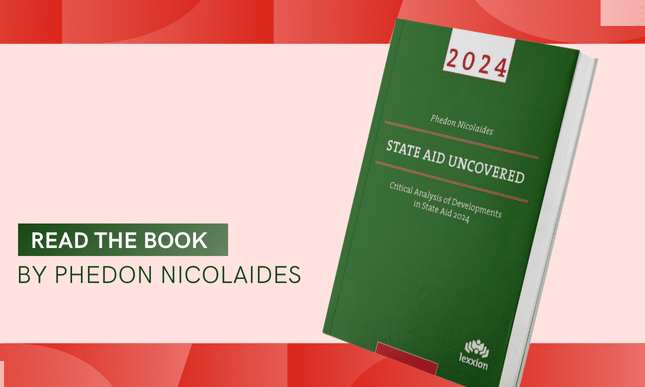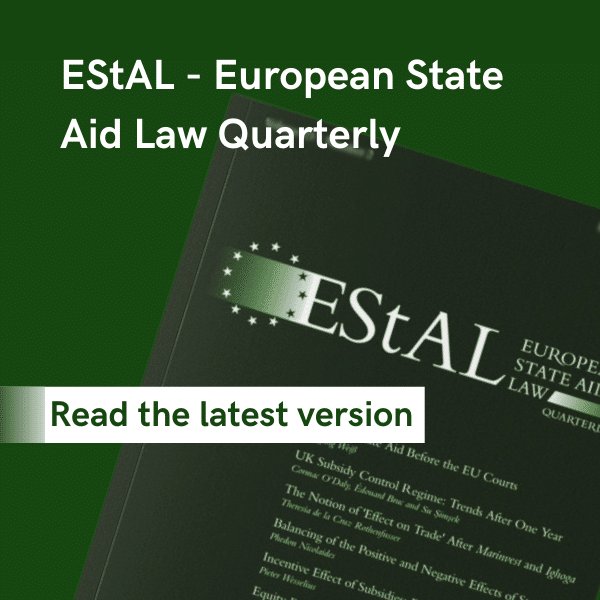
This is the third and last article in a series of three that reviews the Commission’s Notice on the Notion of State Aid.* Last week’s article analysed the concepts of advantage and selectivity. This week the focus is on the last two constituent elements of the notion of State aid: affectation of cross-border trade and distortion of competition. This article also examines the Commission’s treatment of public funding of infrastructure.
Effect on trade and competition
Section 6 of the Notice is rather short; a mere four pages. Unusually it starts with the distortion of competition. Normally, if trade is affected, then competition is almost always found to be distorted. Although these two concepts are distinct, they are “often treated jointly in the assessment of State aid as they are, as a rule, considered inextricably linked” [186]. (The numbers on brackets are the numbers of the paragraphs in the Notice.)
“A measure granted by the State is considered to distort or threaten to distort competition when it is liable to improve the competitive position of the recipient compared to other undertakings with which it competes” [187].
According to the Notice, distortion of competition is excluded if the following cumulative conditions are met:
- The market is closed [legal monopoly in compliance with EU law].
- The legal monopoly not only excludes competition on the market, but also for the market.
- The monopolised product is not in competition with other products.
- If the monopolist is active in another market that is open to competition, cross-subsidisation has to be excluded [there must be separate accounts, costs and revenues allocated appropriately and no cross-subsidisation of the liberalised market] [188].
In other words, there is no distortion when a market is completely isolated from other markets. There is no entry or exit and no possibility of cross-subsidisation between markets or sectors. Such markets may exist, but they are rare. Two frequently encountered examples are the management of the national rail network [where the manager is not at the same time operator of rail services] and the treatment of urban waste. However, it is rare to come across other examples. Hence the guidance of the Notice is useful in theory but will not be useful in practice.
The Notice could have also clarified that distortion is excluded when a measure supports all producers who make competing products. For example, some time ago the UK adopted a measure whose aim was to encourage the consumption of milk. Despite the fact that the state financed an advertising campaign and that milk producers were relieved of marketing costs, no State aid was involved because the campaign was not limited to British milk. Any milk producer in Europe or elsewhere could benefit from selling extra milk in the UK.
With respect to trade, the Notice explains that it is affected when aid strengthens the position of the recipient in relation to its cross-border competitors. “It is not necessary to establish that the aid has an actual effect on trade between Member States but only whether the aid is liable to affect such trade” [190].
“However, an effect on trade between Member States cannot be merely hypothetical or presumed. It must be established why the measure […] is liable to have an effect on trade between Member States, based on the foreseeable effects of the measure” [195].
During the past couple of years the Commission has developed a more rigorous practice in examining both the direct and indirect effects on trade and the actual and potential effects. “The Commission [has] ascertained […] that the beneficiary supplied goods or services to a limited area within a Member State and was unlikely to attract customers from other Member States, and that it could not be foreseen that the measure would have more than a marginal effect on the conditions of cross- border investments or establishment.” [196]
Do you know we also publish a journal on State aid?

The European State Aid Law Quarterly is available online and in print, and our subscribers benefit from a reduced price for our events.
The Commission’s recent practice is based on a more robust and convincing analysis and, therefore, is welcome. It now more systematically examines the possibility of affectation of trade at two levels. First, it considers whether cross-border sales can occur because goods, customers or service providers can physically cross an international frontier or have an economic incentive to cross an international frontier. In most cases, physical movement is possible. The question is whether sellers or buyers have an economic reason to do so. They have such a reason when movement costs little in relation to the value of the good or service they sell or buy. By contract, no ice cream seller will travel far to sell ice cream to, say, ten extra customers. Hence, now the Commission takes into account the tradability of the aided product and its specificity in relation to its location.
Second, the Commission investigates the possibility of direct investment or establishment. Again, if the product is low value, or the demand is not high enough or simply the market is small, it is reasonable to expect that no company would bother to invest in local operations in order to avoid the cost of shipping its product from another site. The cost of investment in local facilities would be higher than the cost of transportation that is avoided.
That is, the Commission looks at both the possibility of movement and the possibility of establishment.
Infrastructure
The penultimate section of the Notice – section 7 – deals with State aid to infrastructure owners, operators and users.
With respect to infrastructure owners, the Notice, first, reiterates the Leipzig-Halle [T-443/08] principle that infrastructure that is inseparably linked to economic activity is itself economic in nature [202]. Infrastructure used by the state to carry out its official functions is not economic in nature [203].
Member States often ask what happens in the case of infrastructure that is not initially intended for commercial purposes but at some point afterwards it is used to carry out an economic activity. The Notice provides an answer. “Where an infrastructure originally used for non-economic activities is later re-assigned to economic use (for example where a military airport is converted to civilian use), only the costs incurred for the conversion of the infrastructure to economic use will be taken into account for the assessment under the State aid rules.” [205]
This answer, however, is problematic. The owner of a non-economic infrastructure is likely to be a public authority. The moment the public authority uses the infrastructure for commercial purposes it becomes an undertaking. The benefit that the undertaking derives is not just the funding of conversion costs. It is the value of the infrastructure that it is put to economic use for free. At minimum, it is the original construction cost minus depreciation. For fully depreciated infrastructure, the value is the revenue it can generate from the use in which it is put.
In the case of research infrastructures that are used mostly for educational [non-economic] purposes, the Commission has developed the concept of ancillarity. This new concept is mentioned in the Notice too. “If the infrastructure is used almost exclusively for a non-economic activity, the Commission considers that its funding may fall outside the State aid rules in its entirety, provided the economic use remains purely ancillary, that is to say an activity which is directly related to and necessary for the operation of the infrastructure, or intrinsically linked to its main non-economic use. This should be considered to be the case when the economic activities consume the same inputs as the primary non-economic activities, for example material, equipment, labour or fixed capital. Ancillary economic activities must remain limited in scope, as regards the capacity of the infrastructure. [Footnote 305 defines a threshold of 20%]. […] The Commission also considers that public financing provided to customary amenities (such as restaurants, shops or paid parking) of infrastructures that are almost exclusively used for a non-economic activity normally has no effect on trade between Member States since those customary amenities are unlikely to attract customers from other Member States and their financing is unlikely to have a more than marginal effect on cross-border investment or establishment.” [207]
The definition of the ancillarity principle, the setting of a precise threshold of 20% and the clarification that public funding of amenities is not likely to constitute State aid are all welcomed developments. They relieve Member States from the obligation and administrative expense of complying with State aid rules in these very marginal cases.
The Notice also clarifies the conditions under which public funding of infrastructure would not be State aid because of insignificant effect on trade. “The Commission considers that an effect on trade between Member States or a distortion of competition is normally excluded as regards the construction of the infrastructure in cases where at the same time (i) an infrastructure typically faces no direct competition, (ii) private financing is insignificant in the sector and Member State concerned and (iii) the infrastructure is not designed to selectively favour a specific undertaking or sector but provides benefits for society at large” [211]. In addition public funding must not cross-subsidise other activities of the infrastructure owner. “Cross-subsidization can be excluded by ensuring that the infrastructure owner does not engage in any other economic activity or — if the infrastructure owner is engaged in any other economic activity — by keeping separate accounts, allocating costs and revenues in an appropriate way and ensuring that any public funding does not benefit other activities” [212].
With respect to the operators of infrastructure, an economic advantage is conferred to them if they pay a price below the market rate for the right to exploit the infrastructure [223]. When a building is rented out, it is rather easy to calculate the rental rate in terms of so many euro per square metre. But the market price of exploiting infrastructure is much more difficult to calculate, especially when there is no similar infrastructure in the same area. The Notice provides no guidance on this point. The economic principle of valuation of an asset is that its market price is equal to the sum of the discounted future stream of net revenue it can generate. However, the Notice explains that no economic advantage is conferred when the right to exploit the infrastructure is competitively tendered out. Therefore, public authorities do not need to agonise about the economic value of infrastructure that is exploited commercially. They can just identify the market-compatible fee by auctioning the right to operate the infrastructure [223].
Lastly, there is no State aid for the users of the infrastructure if the operator sets access prices or usage fees in accordance with the MEOT [225] or auctions the price of access [226]. The Notice concludes the section on infrastructure with the statement that “the Commission considers that the MEO test can be satisfied for public funding of open infrastructures not dedicated to any specific user(s) where their users incrementally contribute, from an ex ante viewpoint, to the profitability of the project/operator. This is the case where the operator of the infrastructure establishes commercial arrangements with individual users that allow covering all costs stemming from such arrangements, including a reasonable profit margin on the basis of sound medium-term prospect. This assessment should take into account all incremental revenues and expected incremental costs incurred by the operator in relation to the activity of the specific user” [228].
There are only few judgments of EU courts on infrastructure. Necessarily, the Notice cannot cite any rich case law. But it usefully summarises and tries to streamline the practice of the Commission which has not always been consistent across sectors.
Conclusions
The Notice is a very good review of the case law and the decisional practice of the Commission. It should be valuable to practitioners because it is a source of important information. It should be welcome by the Member States because it binds the Commission to assess public measures as explained in the Notice. This should bring about more transparent and consistent application of State aid rules not only at the level of the Member States but also at the level of the Commission itself. The State aid regime should become more predictable.
The Notice also seeks, implicitly, to support the Commission’s new approach in the assessment of tax measures and especially tax rulings. In this respect, it goes beyond the mere task of clarification.
On issues which are pending before the Court of Justice, especially those concerning various aspects of selectivity, the Notice is silent. If the Commission wins its appeals, the Notice will continue to remain valid. Otherwise, the Commission will have to issue a revised version.
However, the long gestation period of the Notice that lasted for more than two years indicates that it must have not been easy for the Commission services to agree on its contents and text. It is inevitably the product of compromise. It understandably does not cover in the same detail all controversial issues and it is unlikely to be revised any time soon. It is not the definitive document on the concept of aid but it is a good starting point and for most issues it will also be the ending point.
——————————————————-
* Commission Notice on the notion of State aid as referred to in Article 107(1) of the Treaty on the Functioning of the European Union, OJ C262, 19/7/2016, p.1. The text of the Notice can be accessed at:
http://eur-lex.europa.eu/legal-content/EN/TXT/PDF/?uri=CELEX:52016XC0719(05)&from=EN.



